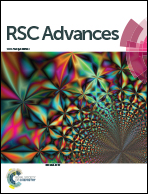Synthesis of mesoporous titanium oxide for release control and high efficiency drug delivery of vinorelbine bitartrate
Abstract
The present study reports a facile method for fabrication of mesoporous titanium oxide (mTiO2) and its application for delivery of the potential anticancer drug vinorelbine bitartrate (VB) under physiological conditions. The mTiO2 was functionalized with hexamethylene tetramine (HMTA), which can release formaldehyde in the acidic environment of cancer cells. Due to the highly porous nature of mTiO2, the drug loading capacity of mTiO2-HMTA was extremely high (about 73%) and the release of the drug was consistent for a long time (about 72 h). The release of VB was pH dependent and found to be higher under slightly acidic conditions thus mimicking a cancer environment. The role of HMTA in the present context is to trigger the release of formaldehyde under acidic conditions (pH 6.5), which was responsible for killing cancer cells, whereas working synergistically with VB. The toxicity of the conjugate was assessed using HeLa and Vero cells. In the case of normal cells, the nano-conjugates were completely biocompatible (>75%). In vivo-toxicity was checked by staining thin slices of the tumor tissues using H&A staining. More damage was found in the case of the tumor cells due to inimical action of formaldehyde.


 Please wait while we load your content...
Please wait while we load your content...